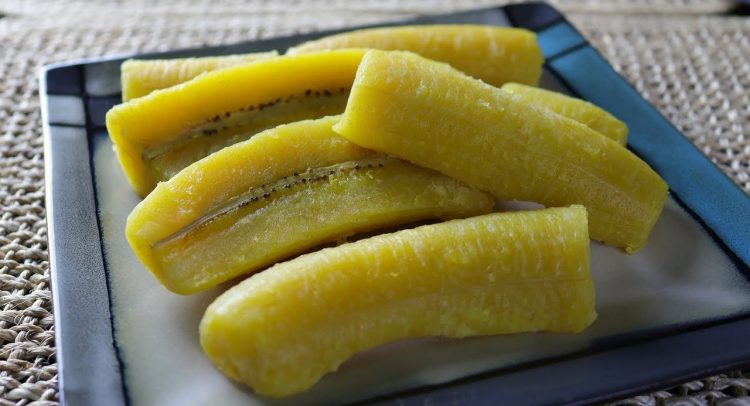Plantains resemble bananas botanically and nutritionally and are common staples in Ghanaian cuisine. They are decent sources of magnesium, potassium, vitamin A, and vitamin K and contain some vitamin C and B vitamins, such as thiamin and riboflavin, according to a journal by Ogidi et al. (2017) published on European Journal of Food Science and Technology. Green, or unripe, plantains are rich in resistant starch, which passes through the digestive system largely undigested and allows blood sugar levels to rise slowly after their consumption. This feature may optimize blood sugar profiles in people with type 2 diabetes and could increase fullness after meals, which aids in weight control. Another benefit of resistant starch is that it feeds the good bacteria in the gut, thereby fostering a healthy gut microbiome. As plantains ripen, large quantities of resistant starch present in unripe plantains turn into sugars. Not only are yellow, or ripe, plantains higher in sugar, but they are also richer in magnesium, potassium, and vitamins C and K than the unripe ones.
Although versatile preparation methods of plantains add variety on the dining table, some of these methods, particularly frying, can substantially downgrade the nutritional quality of plantains. A principal concern associated with fried plantains is that the process of frying increases the fat content of plantains due to absorption and retention of oil, which implies a significant increase in energy intake upon their consumption and can potentially lead to undesired weight gain (Bordin et al., 2013). Frying process can also produce trans fatty acids, whose intake has been associated with an increased risk of cardiovascular disease. Additionally, the quality of oil deteriorates with increased length of frying time. Potentially toxic compounds, including carcinogenic molecules and aldehydes, can appear in frying oils that are reused. In order to minimize the harmful effects of frying, it is important to choose frying oils with superior nutritional features, such as avocado oil and olive oil. It is also recommended to avoid repeated use of frying oil by discarding it after each use. Alternatively, healthier cooking methods including steaming, stir-frying with minimal oil, microwaving, baking, grilling, and boiling can be adopted to help preserve the nutritional quality of foods.
Here is an example of how plantains can be included as part of a healthy diet.
Boiled ripe plantain with beans stew (4 servings)
Ingredients
4 ripe plantains
2 cups black-eyed beans
½ cup palm oil
3 onions, medium, diced
1 habanero pepper, diced
1 cup tomatoes, diced
2 inches ginger, minced
3 garlic cloves, minced
Salmon, medium-sized
Salt, to taste
Instructions
Soak beans in water for one hour.
In a saucepan, boil the beans until they are soft and tender. Add more water to the saucepan when necessary. Once cooked, drain them in colander.
In another saucepan, heat the oil and add the onions, garlic, ginger, and pepper. Let it cook for 1-2 minutes.
Add the tomatoes and let it cook for about 10 minutes. Remove bones from the salmon, then cut them into smaller pieces.
Add the salmon to the sauce and cook for about 5 minutes. Stir intermittently.
Drain the cooked beans and add them to the sauce. Add salt to taste.
Reduce the heat and let it simmer for about 5 more minutes.
Cut both ends of the ripe plantain and cut through the skin lengthwise. Peel and cut the plantains into smaller sizes of your liking.
Boil the plantains in salt water for around 8 minutes or until they are soft. Drain off the water.
Serve boiled ripe plantains with beans stew.
Recipe adapted from: https://www.pulse.com.gh/lifestyle/food-travel/diy-recipe-how-to-prepare-beans-stew-and-boiled-ripe-plantain/9ley6hb
BY K. Coco Zhang, Intern

